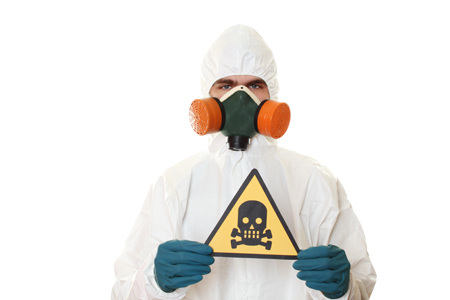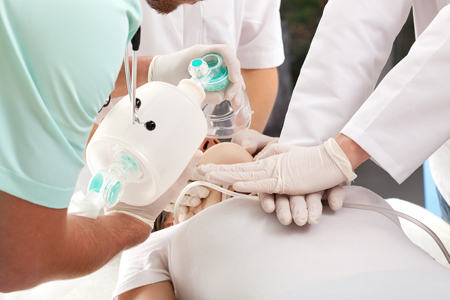Can Mold Kill?
Recently a news article featured a woman who believes that she was poisoned by black mold.
After being exposed to black mold for four years in a friend’s house in Niagra Falls, Susan Crane-Sundell stated: “It’s very close to killing me now.”
Crane-Sundell began getting sick after about 18 months of living in the house. When she got sick, she saw a dozen doctors and underwent expensive medical tests. Recently, she found out that the cause of her sickness was black mold which has poisoned her system to the point that she is bed-ridden.
Can Toxic Black Mold Kill?
This is an interesting question and one that was posed this summer by a reporter in New Orleans, Jed Lipinski, NOLA.com Staff reporter | The Times-Picayune that published an article: Did a moldy building kill 4 New Orleans college professors?
The article poses this question because four SUNO professors, who died within three months of each other, all worked on the second floor of the Multipurpose Building on the SUNO campus:
- Marina Dumas-Hayes official cause of death: breast cancer recurrence;
- Felix James official cause of death: heart disease;
- Sudipta Das official cause of death: breast cancer recurrence;
- Guillarne Leary official cause of death: pulmonary embolism.
Officially, toxic mold is not linked to their deaths because the Centers for Disease Control states that there is no scientific evidence linking mold exposure to pulmonary embolisms, heart disease or breast cancer recurrence. In addition, according to the article:
No federal guidelines exist for what constitutes a safe quantity of mold, making it difficult for inspectors to know whether occupants of a building or home are at risk. Building managers say they often are forced to rely on occupant complaints to determine that a remediation was unsuccessful.
Lipinsky questions the official cause of the death for several reasons.
Background: Water Damage Lead To Significant Mold Infestation
After the levee breaches in late August, 2005, the Southern University of New Orleans (SUNO) campus was one of the hardest hit institutions. In fact, the campus was submerged under water for three weeks and the power plant was not functional, meaning the air conditioning in all 11 buildings was shut off. Power was not restored for two years.
In response, SUNO moved its faculty, students, and staff to temporary buildings that the Federal Emergency Management Agency (FEMA) provided. Efforts to renew SUNO stalled because initial plans to rebuild the campus in another location were rejected by FEMA due to a lack of funding. Conditions inside the 11 buildings continued to worsen as mold spread throughout because the air conditioning was not yet functional.
Three years later, in 2008, work began to clean up the affected buildings.
The Multipurpose Building, a two-story concrete structure, was flooded with 4.5 feet of water after the levee failures during Hurrican Katrina. The state claims the building was deemed safe to occupy before faculty moved in because a licensed contractor, Zimmer-Eschette Services, performed a full environmental remediation during the summer of 2008 and the indoor air samples were deemed “acceptable.” The building was re-opened in August, 2008 so staff could move in for the Fall session.
Air Quality Tests Showed Stachybotrys Mold, Yet Staff Still Allowed To Work In Building!
In over 20 years of studying mold, I have never seen air samples like the ones in this report. (Dr. Richie Shoemaker, a physician and expert in the field of biotoxin-related illness and author of the book “Surviving Mold.”)
This was not a building you wanted to have people working or living in. (David Straus, a retired professor of microbiology and immunology at Texas Tech University Health Sciences Center who spent years doing environmental testing for a Dallas-based company focused on building-related illnesses.)
It seemed like the building hadn’t been cleaned at all. It had that moldy, wet, distinct smell of Hurricane Katrina. (Cynthia Ramirez, tenured professor at SUNO)
Soon after moving into the building, faculty began complaining about respiratory problems.
According to nationally recognized mold experts, the cause of the health complaints was mold because the remediation was not done properly and the indoor air samples were “unacceptable”. In fact, these experts do not believe the building was safe to work in because stachybotrys mold spores were still present and documented in the air quality clearance tests conducted by the AIMS Group.
Stachybotrys was present in 25 of the 62 interior air samples. According to microbiologist, David Straus:
If you find Stachybotrys in a building, let alone in 25 different places, it’s your duty as an environmental remediator to remove it before people move in.
The stachybotrys was not removed because the environmental consultant claimed that it was present in the tests because it came in from the exterior air. Mold experts disagree with this assessment:
The suggestion that 25 interior findings of Stachybotrys has its source in the outdoors is unsupported by any scientific literature at all. If you don’t find Aspergillus or Penicillium in air samples, you’re not outdoors. (Dr. Richie Shoemaker, a physician and expert in the field of biotoxin-related illness and author of the book “Surviving Mold.”)
What Are The Health Effects Of Stachybotrys Mold?
“Since the modes of activity of trichothecenes differ from aflatoxins and other mycotoxins, the combinations of mycotoxins could be additive or even synergistic, which could significantly reduce the amount of either mycotoxin required to induce an immunosuppressive or toxic effect. Immunosuppressive and combinational effects of multiple mycotoxins may constitute major components in the adverse health effects reported by many of the victims of mold exposure.” (A risk assessment model for mycotoxin-producing molds on human health in indoor environments)
According to Michael Pinto, CEO of Wonder Makers Environmental, stachybotrys molds help to decay organic matter, and the species known as Stachybotrys atra (sometimes known as Stachybotrys chartarum) is prone to growth indoors. The lack of power and air conditioning in the SUNO buildings provided the best possible conditions for stachybotrys to grow because there was moisture, food (ceiling tile, drywall, paper vapor barriers, wallpaper, insulation backing, cardboard boxes, and paper files), the right temperature, and lots of time to promote growth.
Stachybotrys is a health concern because studies have demonstrated that exposure, even at low levels can suppress the immune system contributing to bacterial and viral infections, coughing, skin irritation, and other allergic reactions.
The primary reason that stachybotrys is such a major health concern is that it produces a mycotoxin (i.e., poison from a fungus) named trichothecenes. When inhaled or ingested, stachybotrys causes the following health conditions:
- Sore/hoarse throat
- Cold and flu symptoms (headaches, slight fever, and muscle aches)
- Nosebleeds
- Tingling or burning of nose, mouth, and perspiration areas (under the arms or between the legs)
- Chronic fatigue
- Dizziness
- Nausea/vomiting
- Memory loss
- Attention deficit/concentration problems
- Personality changes such as irritability or depression
- Neurological disorders such as tremors
- Hair loss
- Coughing with blood
- Bleeding in the lungs (hemosiderosis)
- Damage to internal organs including blood, liver, kidneys, and lungs
Stachybotrys has even been linked to promoting cancer.
Staff and Faculty Had Recurring Health Issues From Mold Exposure
In the absence of federal regulations on what constitutes a safe amount of mold, humans are often forced to act as canaries in a coal mine, alerting building managers to air quality issues….According to faculty and staff who had offices in SUNO’s Multipurpose Building, the university showed a lack of concern for health complaints between 2008 and 2013.
Considering that stachybotrys was found in the clearance test, it should not surprise anyone that the management of SUNO received many complaints from staff and faculty.
Within months of the move, several faculty were diagnosed with bronchitis. For five years, between 2008 and 2013, Das, Leary, James, and Dumas-Haynes taught classes on the second floor of the Multipurpose Building. Prior to their deaths, both Leary and Dumas-Haynes suffered from severe respiratory problems. They were not the only one’s that suffered as 10 other faculty and staff on the same floor complained of similar symptoms: coughing, wheezing, difficulty breathing, asthma attacks, nausea and migraines.
As complaints mounted, staff demanded that the Administrators test the air quality again. In 2009, SUNO hired the AIMS group to come in and test the air quality, but to the surprise of faculty, the air quality test did not sample the air for mold, but only measured how the air was flowing through the building. Apparently, AIMS did not test for mold because they were not asked to.
According to a former SUNO staff member, it was obvious that the building had a mold problem:
A moldy odor hit you when you walked inside the building. You didn’t need a specialist to know there was mold in there.
The burden of the lack of action rests with the administrators who many staff believe did not take the issue of mold seriously and minimized the health consequences to the point where facilities workers just painted over the mold. Obviously a band-aid solution.
Based on the recurring complaints by staff and the lack of action by administrators, is it fair to conclude that toxic mold did play a role in the deaths of the four Professors?
Did Mold Kill The Four Professors?
The evidence suggests that the water-damaged building was a contributing factor to the occurrence of the four fatalities. (Dr. Michael Gray, a physician and toxicologist in Arizona who has spent more than 20 years treating patients exposed to water-damaged buildings.)
According to the CEO of Wonder Makers Environmental, Michael Pinto, there is mounting evidence that mold causes sickness:
There is now good science that documents that exposure to fungal contaminants and damp environments not only triggers standard allergenic responses, but pushes certain parts of the immune system into overdrive. In essence, the body’s defense system ends up attacking the host as well as the biological invaders. (The Answer to the Mold Illness Questions Is: All of the Above)
In 2009, the World Health Organization, produced a 228 page document entitled WHO Guidelines for Indoor Air Quality: Dampness and Mould and concluded the following:
When sufficient moisture is available, hundreds of species of bacteria and fungi – particularly mould – pollute indoor air. The most important effects of exposure to these pollutants are the increased prevalence of respiratory symptoms, allergies, and asthma, as well as disturbance of the immune system. Preventing (or minimizing) persistent dampness and microbial growth on interior surfaces and building structures is the most important means of avoiding harmful effects on health.
Further, Lipinski, interviewed several experts about the specific causes of death attributed to the four professors.
With respect to Professors Dumas-Hayes and Das, whose documented cause of death was breast cancer, Dr. Maureen Lichtveld, chairwomen of environmental health at the Tulane University School of Public Health, stated the following:
Women in remission from breast cancer often have compromised immune systems, which makes fighting illness and infection more difficult. It is recommended that such women avoid indoor environments where the level of mold or dust exposure would cause public health concerns.
Many mold survivors chronically exposed to mold develop a condition known as Chronic Inflammatory Response Syndrome (CIRS), defined as:
“An accute and chronic, systemic inflammatory response syndrome acquired following exposure to the interior environment of a water-damaged building with resident toxigenic organisms, including, but not limited to fungi, bacteria, actinomycetes and mycobacteria as well as inflammagens such as endotoxins, beta glucans, hemolysins, proteinases, mannans, c-type lectins and possibly spirocyclic drimanes, plus volatile ogranic compounds.” (What is Mold Illness? Better yet, do people get sick after being exposed to water-damaged buildings?)
CIRS is associated with 37 health symptoms, including asthma, dizziness, migraines, and bronchitis. A study in the Journal of Clinical Oncology found that women with chronic inflammation were twice as likely to develop a recurrence of breast cancer, which happenned with both Professors Dumas-Hayes and Das.
Dr. Shoemaker, who has studied CIRS extensively, believes that mold may also have contributed to the deaths of Professors James and Leary because more than 66 percent of those with the diagnosis develop clotting abnormalities, further stating that: “Pulmonary embolism is incredibly common in patients with chronic inflammation and can impact cardiovascular disease as well.”
Dr. Gray agrees with Shoemaker, citing studies showing that people who live or work in water-damaged buildings have a reduced number of “natural killer cells,” which defend against the expression of malignant cells and tumors: “People are much more likely to go out of remission when they are in a water-damaged environment because of the reduction of natural killer cells that environment provokes.”
Key Conclusions About Black Mold!
SUNO killed those people. We told them over and over: It’s not safe in here. But people had to die before anything was done. (Cynthia Ramirez, tenured professor at SUNO)
Some key conclusions can be arrived at based on the article written by Lipinski.
1. The lack of action to remediate the Multipurpose Building led to a large mold infestation, which experts agree was not effectively remediated because the clearance tests showed remaining evidence of stachybotrys within the building.
2. SUNO administration failed to address the health complaints of staff and faculty, at best using band-aid solutions.
3. Staff and faculty suffered from ill health because of continued exposure to stachybotrys mold.
4. The deaths of Professors Dumas-Hayes, Das, James, and Leary were likely hastened by the five years of exposure to the mold.
Staff and faculty did not have to suffer. Once it was found that the air quality tests showed that there was stachybotrys mold still in the building, administration should have taken action. Simply put:
Building owners are responsible for providing a healthy workplace or living environment free of excess moisture and mould, by ensuring proper building construction and maintenance. (WHO Guidelines for Indoor Air Quality: Dampness and Mould)
It appears that only after the deaths of the four Professors that action was taken. In February, 2014, SUNO moved staff out of the offices in the Multipurpose Building and decided to demolish it. SUNO plans to build a new building now. Perhaps, this should have been done in the first place to prevent all the needless suffering.
If you are concerned that you may have toxic black mold in your home or business that requires removal, call Mold B Gone, 678-697-6267 or send us an e-mail.
Article Sources and References
- Did a moldy building kill 4 New Orleans college professors?
- Mold problems and health concerns got ‘Band-Aid solution’ from SUNO, critics say
- ‘Obvious’ mold problem overlooked by SUNO, employees say
- UNO and SUNO’s responses to moldy buildings differ greatly
- 40 minutes pass before emergency help reaches dying SUNO professor
- WHO Guidelines for Indoor Air Quality: Dampness and Mould
- Surviving Mold
- The WHO on Mold
- The Mystery of Mycotoxins in Mold Contamination
- Deposition Of Airborne Spores On Surfaces: The Forgotten Aspect of Mold Remediation
- What is Stachybotrys Mold?
- Explaining Mold Contamination Situations
- A Reasoned Approach To Mold Contamination: Best Practices
- Do People Really Get Sick From a Little Mold in Their House?
- FAQ About Water-Damaged Buildings–Seeing the Big Picture
- The Answer to the Mold Illness Questions Is: All of the Above
- Not All Mold Remediation Is The Same
- Mold Testing: The Old, The New, The Useful
- Medical Evidence that Connects Mold Exposure to Illness Keeps Piling Up
Can Toxic Black #Mold Poison You?: Recently a news article featured a woman who believes that she was poisoned by black…
Posted by Mold-B-Gone Remediation, LLC on Wednesday, December 2, 2015
Can Toxic Black #Mold Poison You? https://t.co/q0cQ6rYMwS PLEASE RETWEET pic.twitter.com/tbBfDLTdI6
— Mold B Gone (@moldbgonega) December 2, 2015


